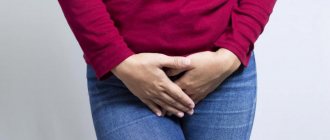The ovaries are the paired female genital organs, which are responsible for the proper production of hormones and the maturation of the egg. Their sizes, reactions and secret activities at different times are not the same.
Quite often, women turn to a gynecologist complaining of pain in the ovarian area. The appearance of pain in the lower abdomen is the main symptom of a disease of the appendages. Most often, pain occurs on the left side, which can radiate to the hip or lower back. In this article we will tell you why the left ovary hurts and in what cases it is necessary to contact a gynecologist.
Causes of pain on the left
If a woman has pain in the ovary on the left, this may indicate not only ovulation or the imminent onset of menstruation, but also the development of diseases of the reproductive organs.
The following are the causes of pain:
- inflammation;
- rupture of the appendage (apoplexy);
- cyst;
- torsion;
- ectopic pregnancy;
- recent pelvic surgery.
Let's look at each cause of pain in more detail.
Inflammatory diseases
If the left ovary is pulled and there is sharp pain in the spine or lower abdomen, this indicates inflammation (oophoritis). The disease first develops in one appendage, and then affects the other. As a result, the patient has pain in the right and left ovaries at the same time. The appearance of oophoritis is facilitated by infection in the pelvic organs. Most often, infection is caused by mycoplasma, ureaplasma and other microorganisms. Inflammation quickly manifests itself in a woman’s body, resulting in pain in the left ovary. This may be tingling in the lower back, pulling or aching pain in the groin area.
Some of the main causes of inflammation are hypothermia, a weakened immune system, and overwork of the body. A woman becomes irritable, has poor sleep, headaches and decreased performance. Soon pain appears in the lower abdomen. Incorrect treatment or its absence leads to the inability to bear a child or become pregnant.
If you experience acute pain in the left ovary or intense tingling in the lower back, you should immediately consult a doctor!
Apoplexy
Ovarian rupture
Apoplexy is a violation of the integrity of the ovary, which is accompanied by increased heart rate, fever, vomiting, weakness and excessive sweating. If the rupture occurred on the left, then, accordingly, the left appendage tingles. The pain is acute, it is impossible to endure it. Sometimes a woman may lose consciousness.
Important! If a woman experiences sharp, acute pain in the ovarian area that cannot be relieved with painkillers, you should immediately call an ambulance! Otherwise, not only internal bleeding may occur, but also death.
Cyst
A cyst is a neoplasm on the ovary, the symptoms of which can easily be confused with other diseases of the pelvic organs. It can occur on both the left and right ovary. If several cysts appear on both appendages, the patient is diagnosed with polycystic disease.
Cystic formation threatens apoplexy, torsion of the leg, and infertility. Increasing in size, the cyst begins to put pressure on nearby pelvic organs. Such pressure leads to poor blood circulation, disruption of the normal functioning of other organs, inflammation and death of appendage tissue. During this period, the girl experiences a dull pain, which is localized on the side where the tumor appeared. For example, a cyst on the left ovary will manifest as discomfort in the left side of the abdomen.
Torsion
Ovarian torsion is a revolution of the ligaments of the appendage, in which there is compression of the vessels and disruption of the nutrition of the ovary. Accompanied by nausea, vomiting, spasmodic and stabbing sensations in the lower abdomen on one side (in this case, the left). Sometimes the left ovary tingles.
Most often, ovarian torsion occurs during sports, heavy work, or other physical activity. As a result, mobility of the appendages occurs, which soon begin to ache. This disease often occurs in active girls during childhood.
Types of incorrect embryo attachment
Apoplexy of paired glands
Apoplexy is a condition in which hemorrhage extends to the ovarian area. It is accompanied by heavy bleeding into the peritoneal area. If a woman who is under forty years old experiences sharp pain in the ovary, then we can say that she has apoplexy. Pathology can take two forms, depending on the symptoms that accompany it. The first form is painful. It is accompanied by severe pain in the appendage area. At the same time, the girl becomes pale, her blood pressure decreases and weakness appears. Other symptoms are not as pronounced as pain. This condition is complicated by painful shock, during which the patient loses consciousness.
The hemorrhagic form manifests itself not only in the form of pain, but also with symptoms of heavy blood loss. Blood pressure begins to drop significantly. Pallor, a feeling of weakness and dry skin appear. The woman may go into shock. Surprisingly, this is affected by a sharp decrease in the amount of blood, and not by pain.
Ectopic pregnancy
If the fertilized egg attaches incorrectly, for example, to the left ovary, an ectopic pregnancy develops. In this case, the woman experiences a pulling or cramping pain on the left side of the abdomen, which radiates to the lower back or rectum.
An ectopic pregnancy should be terminated as early as possible in order not only to prevent the development of complications, but also to preserve reproductive function.
If the left ovary hurts and at the same time there are other signs of a pathological pregnancy (bloody discharge, weakness, etc.), you need to contact a gynecologist and have an ultrasound of the pelvic organs.
Functioning of the ovaries
The ovaries are located to the right and left of the uterus and are connected to it by the fallopian tubes. These organs are the “producers” of eggs and female sex hormones. A woman’s fertility level depends on the health of the ovaries, i.e. ability to conceive and bear a child. The normal size of the ovaries is 30-41 mm in length, 20-31 mm in width, and the normal thickness of the organ is about 14-22 mm. Any deviations from these parameters are a reason to contact a gynecologist and identify the causes of the violations. With normal functioning of the paired gonads, women do not experience severe pain, and the monthly cycle is regular. Various pathologies of the reproductive system can cause discomfort in the ovaries.
Pain after surgery
Absolutely any surgical intervention is considered a major injury and shock to the body. That is why pain after surgical procedures is acceptable and does not pose a threat to the body. But if the ovaries do not stop pulsating, aching, or dragging for several weeks, and the pain intensifies, the woman needs to consult a specialist.
One of the common operations of the appendages is follicular puncture, the postoperative period of which is also accompanied by painful sensations. A woman may also experience discharge with an unpleasant (sour) odor, severe bloating and aching pain in the left ovary. Such signs are associated with injury to the tissues and vessels of the appendage, although the injection itself is practically painless.
During the puncture, a small bleeding wound or hematoma is formed, which aches for some time. The pain lasts no more than five days. If the pain does not subside, is accompanied by fever, unusual discharge appears, bloating or loss of consciousness, you should consult a doctor.
Pain during intercourse
Active sex using a variety of positions is sometimes accompanied by discomfort in the lower abdomen. In this case, pulsation, aching, and pricking may occur in both the left and right ovaries. Unfortunately, this manifestation does not bode well.
The main causes of pain during sex in the left ovary can be:
- inflammation and infections of the genital organs;
- cyst;
- penetration too deep;
- muscle tension;
- cervicitis;
- vaginal dryness;
- adhesive processes.
In any case, if painful sensations are observed with every sexual intercourse, you should consult a gynecologist.
Painful sensations in the left ovary in early pregnancy may indicate the presence of a corpus luteum cyst.
If your periods are late and your ovaries hurt
Most modern girls regularly monitor their menstrual cycle, which allows them to detect even the most minimal delays.
And if menstruation is late and this is accompanied by pain, then many begin to think about the state of their health.
Quite often a situation arises when there is no period and the left ovary or the right ovary hurts. What is the connection between these symptoms?
Cause of pain
First of all, it should be noted that if pain appears before each menstruation, then, most likely, ovulation is just happening. Therefore, minor delay and pain may be due to physiological phenomena. However, if there was no problem before, but now your ovaries hurt and your periods are delayed, you should see a doctor for an examination.
Such manifestations may occur due to:
- The body produces excessive amounts of prostaglandins, which can cause congestion of the pelvic organs;
- Ovarian cyst formation;
- Inflammatory processes in the uterine appendages;
- Onset of pregnancy;
- Endometrial pathologies;
- Ovarian dysfunction;
- Nervous system disorders;
- Late onset of ovulation.
At home, it is impossible to accurately determine the cause of the condition in which there are no periods and the ovaries hurt, since the symptoms of the above problems are very often identical, and additional examination methods are needed.
Excessive production of prostaglandins
It should be noted that prostaglandins perform a large number of functions in our body. One of them is the induction of the onset of menstruation, when a spasm is provoked in the vessels of the pelvic organs. They are also called pain mediators. The more of them there are in the bloodstream, the more pain occurs when menstruation begins.
If the production of these substances is increased or a woman has a low pain threshold, then the ovaries and lower abdomen may become ill during the critical days every month.
Doctors associate the increase in the concentration of prostaglandins with the presence of various toxins in the body.
This means that the ideal way to combat pain is to find the root cause, rather than taking various drugs to relieve pain.
Ovarian cyst
Very often, if your period is not on time, pain appears on the left side, you can suspect an ovarian cyst. This formation does not always manifest itself immediately, since pain appears when the cyst reaches a large size or several cysts develop at once. Most often it affects the left ovary.
Pain appears during the delay before the onset of menstruation due to the fact that it is at this moment that the cyst enlarges and puts pressure on the organ that reacts with pain.
Inflammatory processes in the uterine appendages
The phenomena of inflammation that accompany pathologies such as salpingitis, oophoritis or adnexitis usually become active before critical days.
Usually the ovaries hurt on both sides, but the pain occurs periodically. In some cases, it bothers you for a long time. A characteristic symptom is pain in the lower abdomen radiating to the sacrum.
Quite often, these diseases can be accompanied by the following symptoms:
- Sleep disorders;
- Weakness, lethargy, weakness;
- Irritability and excessive nervousness.
The provoking factor for inflammation of the uterine appendages is usually infectious processes, decreased immunity due to hypothermia, and malfunctions of the immune system.
Late onset of ovulation
A delay in menstruation with accompanying pain in one ovary can be caused by a late onset of ovulation. After the egg is released from the ovary, the follicle ruptures and the corpus luteum is formed. It is responsible for the production of progesterone, which also acts as a regulator of the menstrual cycle.
If disorders have developed in the female body due to which ovulation is delayed, then the corpus luteum will form later, and the synthesis of the hormone will also be delayed. Ultimately, this will lead to a delay in menstruation and the development of pain.
Ovulation can be determined using the following methods:
- A special test for ovulation, however, its results are often unreliable;
- Ultrasound of the pelvic organs gives an answer with high accuracy;
- Blood test for hormone levels.
It should also be noted that disturbances in the functioning of the corpus luteum can be provoked by the presence of hormonal imbalance, excessive stress or infectious processes.
Ovarian dysfunction
The concept of ovarian dysfunction includes all kinds of hormonal pathologies that can be caused by dysfunction of these organs.
They are recognized by a long delay in menstruation and the presence of uterine bleeding after menstruation, which can last more than seven days.
Also, the pathology can be diagnosed due to the irregularity of the onset of menstruation with a decrease in the time interval between them, when it is less than three weeks. They are called dysfunctional uterine bleeding.
The presence of such a pathology can be indicated by severe premenstrual syndrome, amenorrhea - the absence of menstruation for a long time in the absence of pregnancy and female infertility.
Psychogenic causes
Nervous tension can occur with diseases such as depression, hypochondria, emotional burnout, hysteria and others. It can easily affect metabolic processes in the body, as well as cause any pathological process, which may include the development of pain in the lower abdomen when menstruation is delayed.
This diagnosis is established when a comprehensive examination was carried out, during which no possible cause of pain and delayed menstruation was identified.
However, such problems should not be considered safe for the female body, since they can provoke other pathological situations.
In order to eliminate psychosomatic pathologies that lead to changes in a person’s physical status, you should pay attention to your lifestyle. First of all, the factors that cause negativity should be eliminated.
Sometimes consultations and treatment with psychologists and neurologists are necessary, who can prescribe special courses of treatment for psychological and psychosomatic problems.
Summarizing
Regular pain in the lower abdomen during delayed menstruation is quite often physiological, especially when it comes to delayed ovulation. However, if menstruation still does not begin, and the lower abdomen continues to bother you, you should consult a specialist.
Procrastination “for later” will not only add more work to doctors, but will also negatively affect your health.
If, in addition to pain and a delay in menstruation, symptoms such as severe weakness, pain have intensified significantly, and the skin has turned pale, you should immediately call an ambulance, take a horizontal position and not refuse the proposed hospitalization.
Source: https://GormonOff.com/zabolevanija/reproductive/esli-est-zaderzhka-mesyachnyx-i-bolyat-yaichniki
Pain during pregnancy
Among many women, there is an opinion that pain in the ovaries is the main sign that a girl is pregnant. But statistics show that this pain syndrome is absolutely not associated with the appendages. This is due to the fact that during the period of bearing a baby, the uterus stretches, the ovaries rise above the place where they were previously located.
Pain during pregnancy is caused by stretching of the ligaments that support the appendages and uterus. Ovarian tension occurs in women. The expectant mother can cope with such discomfort on her own through proper nutrition, frequent rest and light exercise.
If the pain bothered you even before pregnancy and continues further, then you should visit a doctor. It is necessary to find out the causes of pain in the left ovary as early as possible, since it can not only be enlarged, but also pose a threat to the child.
You should also remember the preparation for conception and preventive methods of diseases even before pregnancy, since the appendages can get sick already during pregnancy and have completely different consequences, including miscarriage and placental abruption.
How to treat in this case
No woman can cope with pain in the ovaries without the help of specialists. With such a problem, she is given general recommendations: keeping quiet, taking painkillers, minimizing physical activity, stress and conflicts. You will need to pay attention to nutrition and give up bad habits. If a girl has suspicions about the connection of the pain syndrome with any diseases, especially in an acute form, then she should not treat it on her own. In this case, you need to contact a gynecologist or contact the ambulance team. Taking painkillers and anti-inflammatory medications will not be enough. In this case, treatment for the cause of the pathology is prescribed. The use of each drug must be strictly discussed with your doctor.
Causes of pain not associated with serious illnesses
The main reason why the ovary may hurt is considered to be hormonal changes in the female body that occur during menstruation and ovulation. Ovulation is accompanied by the rupture of the dominant follicle and the release of the egg. As a result, irritant effects occur on the nerve endings, which can lead to variable pain on both sides at once. However, if a mature egg has come out of a follicle located on the left ovary, then, accordingly, there will be discomfort on the left. There have been cases when women felt ovulatory pain even at 8 DPO (day after ovulation)
Many people are interested in why pain occurs in the appendage area during menstrual periods. This is due to a decrease in estrogen levels or endometriosis. It is endometriosis that manifests itself most during menstruation. A woman experiences not only pain in the appendages, but also constant nausea, weakness, loss of strength, and difficulty urinating and defecating.
Primary diagnosis and pain relief
As mentioned earlier, if a girl feels discomfort in the left ovary, then there are various reasons for this. Some do not pose a threat to health and disappear on their own in the near future. Others appear periodically and with varying intensity. It is these symptoms that should alert you, as they can lead not only to a deterioration in your general health, but also to infertility. What to do in this situation? The first thing you need to do is contact a specialist and undergo a gynecological examination. Using palpation, the gynecologist will palpate the ovaries, determine their size and localization of pain. This pressure on different areas of the lower abdomen makes it possible to find out the main cause of discomfort in the left ovary and will direct you to an ultrasound to confirm or refute the diagnosis. To determine the cause for sure, a specialist may also prescribe tests.
You can relieve painful symptoms yourself. However, this should only be done after consulting a doctor. To do this, you must adhere to the following recommendations:
- pause training and avoid other intense physical activities;
- eat well and add as many vitamins as possible to your diet;
- do not drink or smoke;
- avoid conflict situations and stress;
- take painkillers.
Thus, the appearance of even minor pain in the left ovary requires a mandatory examination and compliance with all the instructions of a specialist.









